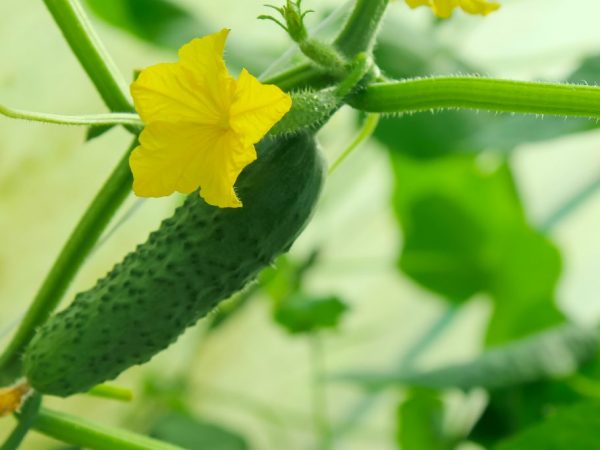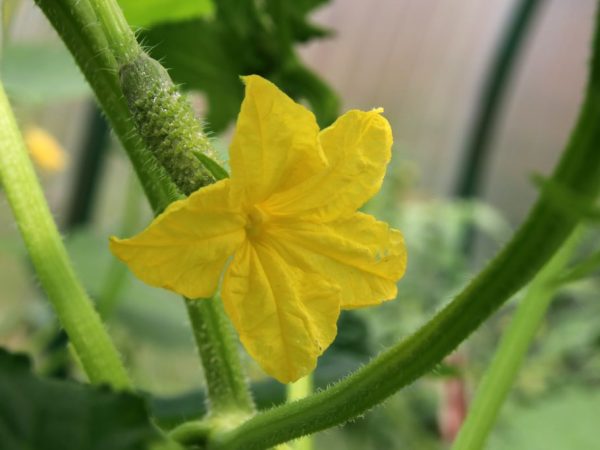Growing early cucumbers in a greenhouse
There is a need for vitamins all year round, but vegetables sold in supermarkets are not always tasty and environmentally friendly. Growing early cucumbers in a greenhouse can solve this problem.

Growing early cucumbers in a greenhouse
Which varieties to choose
Choosing the right strain is half the battle. Quality seeds are guaranteed seedlings and a high yield. In temperate and cold climates, it is better to plant hybrid varieties, as they tolerate insufficient consecration well. At low temperatures, insects are not very active, which means that pollination will be difficult, it is necessary to choose self-pollinated varieties.
F1 cucumbers have shown themselves to be good. Residents of Central Russia and Siberia recommend planting cucumbers of the following varieties: Buyan, Muravei, Murashko, Khalli, Marinda, Bidretta, Twiksi. They are resistant to diseases, high yield, unpretentious.
For early plantings in greenhouses, gardeners choose hybrids with long fruits: Lada, Malachite, Biryusa, Early 166, Nerosimy 40, Altai, Vir 517, Muromsky 36, Kustovoy, Othello, Stella, Satina, Graceful, Vyaznikovsky, Vir 516.
On the 50th day after germination, such hybrids as Gribovskie 2 and Mayskie give a harvest. Super early variety - Zozulya F1, bears fruit already on the 42nd day.
Soil preparation
In order for your crop to bear fruit, you must not only build your own greenhouse, but also prepare the land for cucumbers. It is necessary to make a hot bed - based on compost or pus. Preparation is carried out in the spring.
Compost cultivation
Compost is organic waste (peat, manure, leaves, tops, sunflower stalks, feces, waste, corn stubs, weeds from the garden, peels of vegetables and fruits) are also suitable. But we need our compost to play the role of a heat accumulator and warm our soil. To do this, add fresh waste and greens, the compost will catch fire. Organic waste will be processed faster if you add special preparations or manure.
The essence of creating a warm bed of cucumbers in a greenhouse is to put our compost (20-30 cm) on the bottom, and pour a layer of earthen substrate (20 cm) on top. In a greenhouse insulated with compost, germinated seeds germinate better. The method of planting peat tablets and cups is excellent.
The compost method produces less heat than the manure method, so it is suitable for warmer climates.
Growing on manure
Preparing a warm bed for growing early cucumbers in a greenhouse on manure is not much different from the compost method. It is necessary to put fresh manure, which has reached a state of flammability, under the garden bed. To do this, throw out the soil 40 centimeters, depending on how much fertilizer you have, then throw in 10-20 cm manure.All this is covered with an earthen substrate of 20-25 cm.
It all comes down to the fact that manure placed on the bottom warms the earth. The temperature rises so much that you can get burned. Thanks to this, the first shoots will appear in 4-5 days from the moment of planting.Hot beds can easily burn your plant - you need to adjust the temperature.
Airing is carried out very carefully. Regular and gradual airing will harden and strengthen your plant, making it more resistant to temperature extremes. Watch out for the weather conditions, the sunlight heats up the garden a lot. It is necessary to install thermometers and monitor the optimum temperature of 17-30 °. Airing is carried out when the temperature has risen above 30 °. Plants in such a structure receive all the necessary nutrients and moisture.
Landing

Stick to planting dates
April 1-5 - suitable for gardeners and summer residents who have provided their seedlings with technical heating or hot beds.
April 20-25 - for greenhouses and biofuel greenhouses without technical heating. For the rest, who do not have additional heat, land at the beginning of May.
Moisten the soil before planting.
When sowing seeds, remember that the cucumber will grow in the future. It is necessary to maintain a distance of 1 square meter. Seeds that will sit in a manure bed do not require germination or soaking. Throw 2-3 seeds into the hole. To provide additional heating, cover the bed with a film, create a greenhouse effect.
Care
As a rule, a warm bed provides the plants with all the necessary elements, but some summer residents feed them with mineral or organic fertilizers. When using straw or dry grass, processing requires air - it is recommended to feed with fertilizers based on nitrogen. It is necessary that the soil be light, loose - this will provide oxygen permeability.
Watering is carried out regularly. Before flowering, watered once a week, sometimes more often. After flowering, watered more often every 2-3 days.
Tying the bushes is a very important step. If you do not provide a cucumber with sufficient space, then it bears less fruit. Tied to a trellis, which is tied to a wire. It is necessary to stretch the wire 1.5-2 m along the row.
We grow 8 - 9 true leaves, then it is necessary to form a bush. The plant will actively grow upward, and take away all moisture and nutrients - you need to pin it.
Pest control
It is easy to grow cucumbers without chemical treatment, the main thing is to do prevention on time and take the necessary measures:
- monitor each bush;
- cover the doors and windows of the greenhouse with gauze, make glue traps - it will protect from the greenhouse whitefly;
- spraying with a solution of pepper - will destroy aphids;
If the greenhouse whitefly is on your cucumbers, spray the plant with water and loosen the soil.
Can be treated with an infusion of wood ash, laundry soap. You can also use chemicals.
Conclusion
Growing cucumbers in a heifer can seem like a daunting task. But if you adhere to the simple rules and recommendations of experienced vegetable growers, then you will get the most delicious cucumbers.
Creating a hot bed will provide the cucumbers with warmth and all the necessary elements. With proper care, the plant can be grown without chemical treatment. Take care of your plants and they will bring you a rich harvest.


